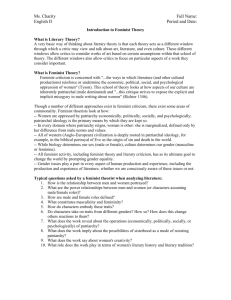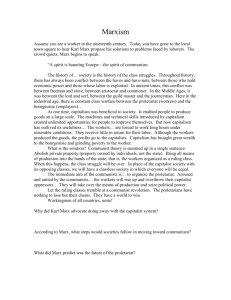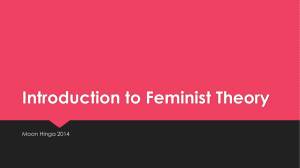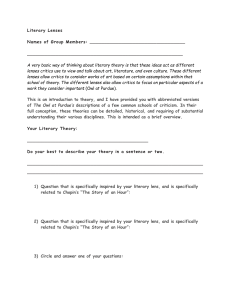Critical Lenses
advertisement
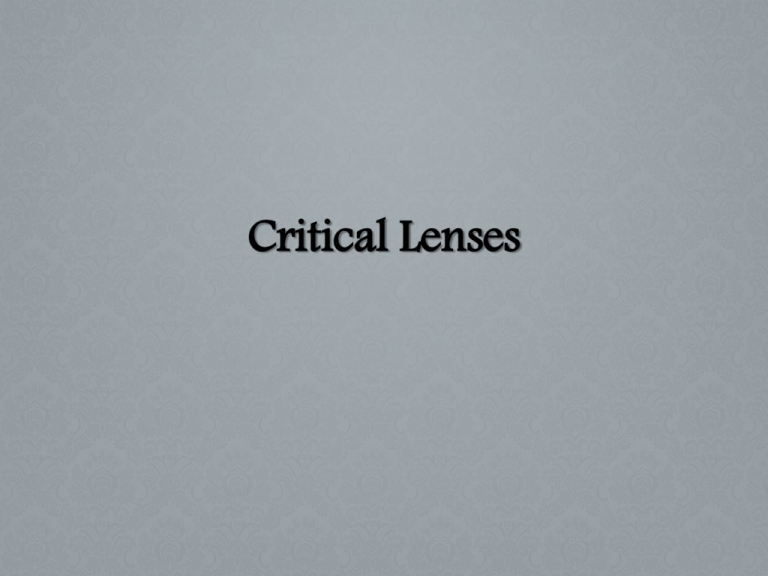
Critical Lenses Reader Response Criticism • Focuses on the activity of reading a work of literature. • Reader response critics shift the meaning of a work from the traditional view of the work as an achieved structure of meanings and focus more on the responses of readers to the text. • By this shift of perspective, a literary work is converted into an activity that goes on in a reader’s mind, and what had been features of the work itself – narrator, plot, characters, style, and structure – is less important than the connection between a reader’s experience and the text. • Reader response critics believe that literature has no objective meaning or existence. • This is a more individualized lens as each reader has his or her own life experiences that influence their critique of a literary work. Questions a Reader Response Critic might ask: • What factors surrounding my reading of the text are influencing my response? • What personal qualities or events relevant to this particular text might influence my response? • What textual factors might influence my response? Historical Criticism • Historicists aim simultaneously to understand the work through its historical context and to understand cultural and intellectual history through literature. • Two main ideas of historical criticism are: 1. The social, political, and cultural context (historical influences) affect the creation of works of literature. 2. The meaning of literature changes over time as these same contexts change. Questions a Historical Critic might ask: • What were the responses of the original audience? • What are the meanings and implications of specific words, symbols, images, and characters throughout time? • How do contemporary events influence the writing of the author? Socialist/Marxist Theory • Karl Marx was a German philosopher, economist, sociologist, journalist in mid-19th c. • Marx believed that history moved in stages which were mainly shaped by economic systems: 1. 2. 3. 4. Feudalism: the power of the ruling class comes from their control over fruitful land, leading to the control and exploitation of the peasants who farmed that land Capitalism: economic and political system defined by a country’s trade being controlled by private owners for profit, rather than by the state. Socialism: social organization that requires production, distribution, and exchange to be controlled by the community as a whole. Communism: society in which all property is publicly owned and each person works and is paid according to their abilities and needs. Marx continued… • The key to understanding Marx’s economic systems was to focus on the “mode of production.” • Example: – Feudalism = agricultural production – Capitalism = industrial production • An understanding of who owned the means of production is also necessary. • Example: – Capitalism = a small upper class owned factories – Socialism = larger working class owned factories • Each system, up to and including capitalism, was characterized by the exploitation of one class by another • Each system also perpetuated itself as a social norm (no one during the Middle Ages really questioned feudalism because that was the understood norm of society). An investigation into the validity of Marx’s theories • Marx argued that great historical changes followed a three-step pattern called thesis-antithesissynthesis. • Any idea or condition (thesis) brings into being its opposite (antithesis). The two opposites then conflict until they produced a new, higher stage (synthesis). • Therefore, each class system contained the seeds of its own destruction. – Example: Marx saw capitalism as the cruelest, most efficient system yet evolved for the exploitation of the working majority by a small class of owners. It was the nature of capitalism for wealth and ownership to be concentrated in an ever-shrinking mega-rich class. Questions a Marxist might ask: Who is in the upper class? How is the upper class ruling the lower class? How close is a particular society to communism? Whom does it benefit? What is the social class of the author? What values does it reinforce? What values does it subvert? What conflict can be seen between the values the work champions and those it portrays? • What social classes do the characters represent? • How do characters from different classes interact or conflict? • • • • • • • • Feminist Theory • Feminism is a philosophy in which women and their contributions are valued. It is based on social, political and economical equality for women. • Feminists can be anyone in the population: men, women, girls or boys. • Most societies are structured upon a patriarchy (an ideology in which men are superior to women and have the right to rule women). • Feminism can also be described as a movement or a revolution that includes women and men who want the world to be equal without discrimination. Feminists view the world as being unequal. Lois Tyson Lois Tyson is a professor of English at Grand Valley State University. She is an active Feminist and we will be using her interpretation of Feminist theory to understand this critical lens. Feminist Critique of Literature • Feminist criticism of literature is concerned with the ways that literature reinforces the oppression of women socially, economically, politically and psychologically. • This critical theory looks at how aspects of our culture are inherently patriarchal (male dominated) and tries to expose misogyny (hate of women) in male writing about women. (Tyson, 83) (Richter, 1346) Feminist critical theory argues that… 1. Women are oppressed by patriarchy economically, politically, socially, and psychologically 2. In every domain where patriarchy reigns, woman is the other: she is marginalized, defined only by her difference from male norms and values 3. All of western civilization is deeply rooted in patriarchal ideology, (ex: the biblical portrayal of Eve as the origin of sin and death in the world ) 4. Biology determines our sex (male or female), culture determines our gender (masculine or feminine) 5. Gender issues play a part in every aspect of human production and experience whether we are consciously aware of these issues or not. Questions a Feminism Theorist might ask: • How is the relationship between men and women portrayed? • What are the power relationships between men and women? • How are male and female roles defined? • What constitutes masculinity and femininity? • How do characters embody these traits? • Do characters take on traits from the opposite gender? How? How does this change others’ reactions to them? • What does the history of the work’s reception by the public and by the critics tell us about the operation of patriarchy? • What role does this work play in terms of women’s literary history and literary tradition? Post-colonial Theory • Post-colonial critics are concerned with literature produced by colonial powers and literature produced by those who were/are colonized. • Post-colonial theory looks at issues of power, economics, politics, religion, and culture and how these elements work in relation to colonial hegemony (leadership or dominance). – For example, Joseph Conrad’s Heart of Darkness vs. Chinua Achebe’s Things Fall Apart • Post-colonial critics also question the role of western academia as the dominant form of knowledge making. Questions a post-colonial theorist might ask: • How does the literary text represent various aspects of colonial oppression? • What does the text reveal about the challenges of postcolonial identity, including the relationship between personal and cultural identity and such issues as double consciousness and hybridity? • What person(s) or groups does the work identify as “other” or stranger? How are such people/groups described and treated? • Are there meaningful similarities among the literatures of different post-colonial populations? • How does a western text reinforce or undermine colonialist ideology through its representation of colonization and/or its inappropriate silence about colonized peoples?


